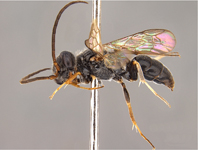Abstract
We diagnose a new butterfly species from the Belmira paramo in the central cordillera of the Colombian Andes. We infer from the barcoding analysis, wing pattern, morphology and distribution that this entity is not a geographical variation or subspecies of any named lycaenid, and it is described herein as Rhamma eleonorae sp. nov. Adult specimens and female genitalia are illustrated and compared with R. arria (Hewitson, 1870) and R. oxida (Hewitson, 1870), the most closely related taxa based on similarities of wing pattern and COI sequences.
References
deWaard, J.R., Ivanova, N.V., Hajibabaei, M. & Hebert, P.D.N. (2008) Assembling DNA barcodes: analytical protocols,. In: Martin, C. (Ed.), Methods in molecular biology: environmental genetics. Humana Press Inc, Totowa, New Jersey, pp. 275–293.
https://doi.org/10.1007/978-1-59745-548-0_15
Hebert, P.D.N., Penton, E.H., Burns, J.M., Janzen, D.H. & Hallwachs, W. (2004) Ten species in one: DNA barcoding reveals cryptic species in the neotropical skipper butterfly Astraptes fulgerator. Proceedings of the National Academy of Sciences of USA, 101 (41), 14812–14817.
https://doi.org/10.1073/pnas.0406166101
Huelsenbeck, J.P. & Hillis, D.M. (1993) Success of phylogenetic methods in the four-taxon case. Systematic Biology, 42, 247–264.
https://doi.org/10.1093/sysbio/42.3.247
Ivanova, N.V., deWaard, J.R. & Hebert, P.D.N. (2006) An inexpensive, automation-friendly protocol for recovering high-quality DNA. Molecular Ecology Notes, 6, 998–1002.
https://doi.org/10.1111/j.1471-8286.2006.01428.x
Johnson, K. (1992) Genera and species of the Neotropical “elfin”-like hairstreak butterflies (Lepidoptera, Lycaenidae, Theclinae). Reports of the Museum of Natural History, University of Wisconsin, 22, 1–279.
Kimura, M. (1980) A simple method for estimating evolutionary rate of base substitutions through comparative studies of nucleotide sequences. Journal of Molecular Evolution, 16, pp. 111–120.
https://doi.org/10.1007/BF01731581
Klots, A.B. (1970) Lepidoptera. In: Tuxen, S.L. (Ed.), Taxonomist’s Glossary of Genitalia in Insects. 2nd Edition. Munksgaard, Copenhagen, pp. 115–130.
Kumar, S., Stecher, G. & Tamura, K. (2016) MEGA7: Molecular Evolutionary Genetics Analysis version 7.0 for bigger datasets. Molecular Biology and Evolution, 33, 1870–1874.
https://doi.org/10.1093/molbev/msw054
Kumar, S. & Gadagkar, S.R. (2000) Efficiency of the neighbor-joining method in reconstructing deep and shallow evolutionary relationships in large phylogenies. Journal of Molecular Evolution, 51, 544–553.
https://doi.org/10.1007/s002390010118
Mihaescu, R., Levy, D. & Pachter, L. (2009) Why neighbor-joining works. Algorithmica, 54, 1–24.
https://doi.org/10.1007/s00453-007-9116-4
Mutanen, M., Kivelä, S.M., Vos, R.A., Doorenweerd, C., Ratnasingham, Hausmann, A., Huemer, P., Dincă, V., van Nieukerken, E., Lopez-Vaamonde, C., Vila, R., Aarvik, L., Decaëns, T., Efetov, K., Hebert, P., Johnsen, A., Karsholt, O., Pentinsaari, M., Rougerie, R., Segerer, A., Tarmann, G., Zahiri, R. & Godfray, H.C. (2016) Species-Level Para- and Polyphyly in DNA Barcode Gene Trees: Strong Operational Bias in European Lepidoptera. Systematic Biology, 65 (6), 1024–1040.
https://doi.org/10.1093/sysbio/syw044
Prieto, C. & Vargas, M.A. (2016) Elfin butterflies of the genus Rhamma Johnson (Lepidoptera: Lycaenidae: Theclinae): A review of the Colombian species. Zootaxa, 4093 (3), 323–342.
https://doi.org/10.11646/zootaxa.4093.3.2
Prieto, C. & Lorenc-Brudecka, J. (2017) Description of Rhamma dawkinsi (Lepidoptera: Lycaenidae) a new mountain butterfly from Colombia. Zootaxa, 4338 (3), 587–594.
https://doi.org/10.11646/zootaxa.4338.3.12
Prieto, C., Nuñez, R. & Hausmann, A. (2018) Molecular species delimitation in the genus Rhamma Johnson, 1992 (Lepidoptera: Lycaenidae, Theclinae). Mitochondrial DNA, 30 (1), 1–17.
https://doi.org/10.1080/24701394.2018.1462348
Robbins, R.K. (1991) Evolution, comparative morphology, and identification of the Eumaeini butterfly genus Rekoa Kaye (Lycaenidae. Theclinae), Smithsonian Contributions to Zoology, 498, 1–64.
https://doi.org/10.5479/si.00810282.498
Robbins, R.K. (2004a) Introduction to the Checklist of Eumaeini, Lycaenidae. In: Lamas, G. (Ed.), Checklist of Neotropical Lepidoptera. Part 4A. Hesperoidea-Papilionoidea. In: Heppner, J.B. (Series Ed.), Atlas of Neotropical Lepidoptera. Scientific publishers, Gainesville, pp. xxiv–xxx.
Saitou, N. & Nei, M. (1987) The neighbor-joining method: A new method for reconstructing phylogenetic trees. Molecular Biology and Evolution, 4, 406–425.
Torres-Nuñez, R., Hall, J.P, Willmott, K.R. & Johnson, K. (1996) A New Genus of “Elfin” Butterflies from the Northern High Andes (Lepidoptera: Lycaenidae). Tropical Lepidoptera, 7, 81–86.
Winter, W.D. (2000) Basic Techniques for Observing and Studying Moths and Butterflies. The Lepidopterists’ Society, Memoir 5, i–xviii + 1–444.


